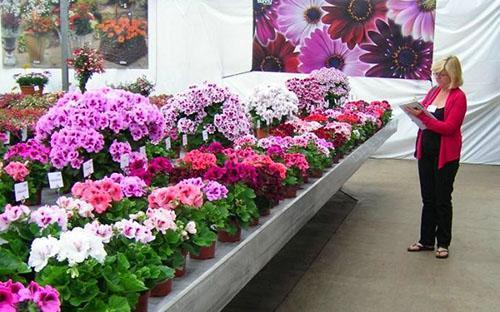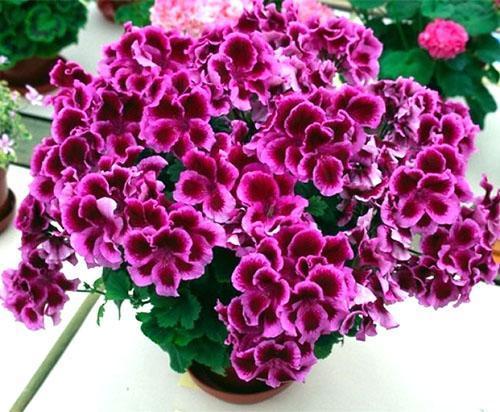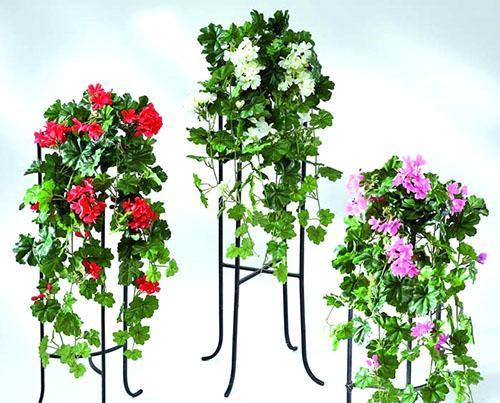How to properly care for pelargonium at home?
 More recently, a blooming geranium bush on the windowsill has been an indispensable attribute of a prosperous family. It was believed that pelargonium is the keeper of the hearth. The unpretentious plant has made room and gave way to new types of flowers. Geranium is not forgotten, often care at home pelargonium gives the first experience and develops into a hobby.
More recently, a blooming geranium bush on the windowsill has been an indispensable attribute of a prosperous family. It was believed that pelargonium is the keeper of the hearth. The unpretentious plant has made room and gave way to new types of flowers. Geranium is not forgotten, often care at home pelargonium gives the first experience and develops into a hobby.
Read also the article in the topic:hippeastrum - home care!
Geranium history and variety of varieties

There are so many varieties of pelargonium that even the classification goes according to different criteria. Talking about indoor flowers, we use the classification by decorativeness:
- zonal;
- ampelous;
- fragrant;
- succulent.
 There are also varieties "Angels" and "Unicums". All of them tolerate indoor living conditions well and bloom almost continuously with good care. Pelargoniums differ in the shape and color of leaves and buds, but all are invariably fragrant and their esters are healing.
There are also varieties "Angels" and "Unicums". All of them tolerate indoor living conditions well and bloom almost continuously with good care. Pelargoniums differ in the shape and color of leaves and buds, but all are invariably fragrant and their esters are healing.
In summer, geraniums are exposed under an open window. It is believed that the plant on the windowsill drives out flies from the dwelling. The leaves are applied to abrasions and cuts for quick wound healing.
How to properly care for geraniums?
 Reproduction of pelargonium will not create difficulties. It is enough to tear off the petiole from the plant or buy a bag of seeds. Seed propagation of pelargonium gives a more spectacular plant with large flower caps.
Reproduction of pelargonium will not create difficulties. It is enough to tear off the petiole from the plant or buy a bag of seeds. Seed propagation of pelargonium gives a more spectacular plant with large flower caps.
By cuttings, you can quickly get a flowering plant. Rooting can occur both after the rootlets are placed in the water, and when rooting in the ground. Since the plant easily takes root, you can create a mini-greenhouse and plant several petioles. Later, after soaking the substrate, disassemble them and place them in separate bowls.
 Soils for pelargonium have a different composition:
Soils for pelargonium have a different composition:
- leafy earth, humus, turf in equal parts plus half of the sand;
- if the leaf land is replaced by peat, then the proportions of all components, including sand, are the same;
- garden soil, peat and sand in equal parts.
You can buy special soil for these plants at the flower shop. In this case, any soil should first be disinfected in any available way. The container with a drainage hole should not be spacious, pelargonium blooms if the roots are cramped.
 The place where the geranium was placed must be sunny. In winter, the flower loves to rest. During the resting period, the temperature drops to 13 = 15 degrees and shading is created. But if it is impossible to provide such conditions, that is, as a rule, the warmer, the higher the illumination, up to highlighting. And then the plant will not feel discomfort.
The place where the geranium was placed must be sunny. In winter, the flower loves to rest. During the resting period, the temperature drops to 13 = 15 degrees and shading is created. But if it is impossible to provide such conditions, that is, as a rule, the warmer, the higher the illumination, up to highlighting. And then the plant will not feel discomfort.
Pelargonium cannot be fed in winter.
 Geranium is watered every other day in summer, when it is hot, but waterlogging can lead to root rot, black leg. Therefore, it is watered more often in summer, rarely in winter. Geranium will survive the drought and recover, and excess water can kill it.It is worth recalling that the water for irrigation must be warm and settled. Fertilizing fertilizing with flower liquid formulations is done in a week, except for the rest period. For geraniums, a special mixture has been released, called "Pelargovit".
Geranium is watered every other day in summer, when it is hot, but waterlogging can lead to root rot, black leg. Therefore, it is watered more often in summer, rarely in winter. Geranium will survive the drought and recover, and excess water can kill it.It is worth recalling that the water for irrigation must be warm and settled. Fertilizing fertilizing with flower liquid formulations is done in a week, except for the rest period. For geraniums, a special mixture has been released, called "Pelargovit".
As soon as the roots begin to make their way into the drainage hole of the pot, the pelargonium needs to be transplanted. The plant is transplanted in early spring after 1-2 years. During the growing season, the soil must be loosened, while checking if pests or diseases have settled on the plant.
 There are few reasons why pelargonium does not bloom. The appearance of the plant will help identify the problem.
There are few reasons why pelargonium does not bloom. The appearance of the plant will help identify the problem.
- The plant has good leaves, develops quickly, but does not bloom. There is fattening. Stop fertilizing watering and dry the flower. If the container is large, there will be no flowering until the roots fill the spaces.
- Lacks lighting... Put the plant in direct sunlight, if there are no light southern windows in the apartment, arrange additional lighting.
- If a yellow border appears on the leaves, the plant has a depressed appearance, check for root and stem rot. Inspect the leaves for the presence of whiteflies or other insects.
 Detailed information on pelargonium diseases and how to deal with them can be found on the website. We can say that problems arise from improper care. Often a pest or disease is brought in with soil or a new plant that has not passed quarantine exposure. Therefore, hygiene requirements are important, since it is difficult to eradicate the disease at home.
Detailed information on pelargonium diseases and how to deal with them can be found on the website. We can say that problems arise from improper care. Often a pest or disease is brought in with soil or a new plant that has not passed quarantine exposure. Therefore, hygiene requirements are important, since it is difficult to eradicate the disease at home.
The plant loses its decorative effect with dry air, overfeeding with nitrogenous fertilizers or the appearance of downy mildew. Timely detection of the disease will allow you to save the plant or take cuttings from it.